Aesop's Life and Legend

Francis Barlow. Æesop's Fables.
(London: 1687).
No author of Greek antiquity has been more read, translated, adapted, embellished, printed, and illustrated than Aesop. Who was he? Did he even exist?
According to Herodotus (Histories, 2.134-135), Aesop was a slave who won his freedom by telling fables. Herodotus says Aesop was the companion of the beautiful courtesan Rhodopis, about 2600 years ago. Aesop is mentioned by Aristotle, Aristophanes, Athenaeus, Plato, Callimachus, Lucian, Philostratus, Pliny, Plutarch, Seneca, Strabo, and Zenobius. In his last days Socrates versified Aesop.
In the thirteenth century, a Life of Aesop was put together in Constantinople by Maximus Planudes (c. 1260-c. 1305), a scholar, translator, editor, and monk. To supplement his collection of Aesop's fables, Planudes took bits from the life of Ahiqar, an ancient Syrian sage, added an episode from the story of Joseph, filled in the rest, and gave us an Aesop in full career. Planudes's amazing Aesop quoted Euripides eighty years before the Greek playwright had even been born.

Roger L'Estrange. Fables of Aesop.
(London: 1692).
The Life is considered a Greek romance, or legend, or fable. It begins with Aesop enslaved and miserable. It ends with Aesop free, a world traveler, framed, tried, convicted, and executed for theft and blasphemy at Delphi.
Latin translations of Planudes's Life circulated in Europe in the 1400s. German, French, and English translations soon followed. In them Aesop, "the great benefactor of mankind," was a "turnip with teeth," "potbellied, misshapen of head, snub-nosed, dwarfish, bandy-legged, short-armed, squint-eyed, liver-lipped—a portentous monstrosity."
According to Planudes, Aesop was born mute. After he showed kindness to a priestess of Isis the priestess prayed for him and Isis answered. Isis and the Muses gave Aesop the gifts of speech and storytelling.
In no time he began mouthing off, talking back to his master, and, at the price of a couple of beatings, getting the best of him. He is a familiar comic type, the intelligent and insolent servant.
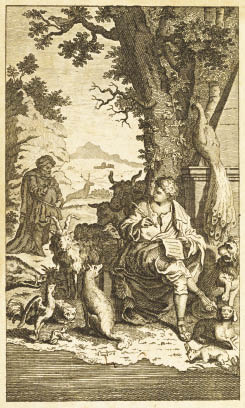
Samuel Croxall. Fables of Aesop
and others. (London: 1760).
Sources do not agree about when Aesop lived, whom he met, or where he came from. Herodotus says Aesop came from Thrace; according to Phaedrus, Aesop was from Phrygia, on the other side of the sea. The Isis episode makes a case for Egypt. Plutarch put Aesop in the company of the Seven Sages of Greece. Several commentators believed that the name "Aesop" was derived from Aethiops (Ethiopia). In Francis Barlow's edition, when Aesop is asked who he is he answers, "A Negro."
Planudes' Life has been well illustrated, most memorably in Barlow's Æsop's Fables, With His Life, in English, French, and Latin (1687). Barlow drew pages and pages of Aesop, illustrating thirty-one episodes of the Life, including all four occasions when Aesop was accused of a crime.
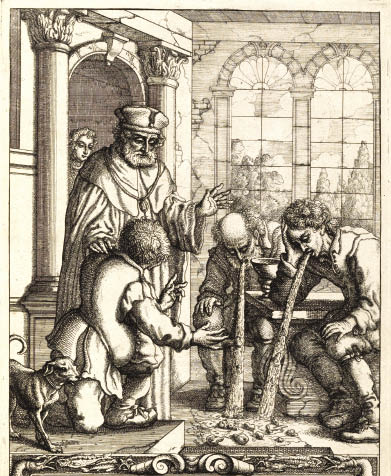
Francis Barlow. Æsop's Fables. (London: 1687).
Aesop was accused of stealing figs when still mute. He defended himself brilliantly by throwing up, showing that he had had no figs that day. Aesop gestured for the servants to throw up for the master, and they did. The vomit revealed the thieves.
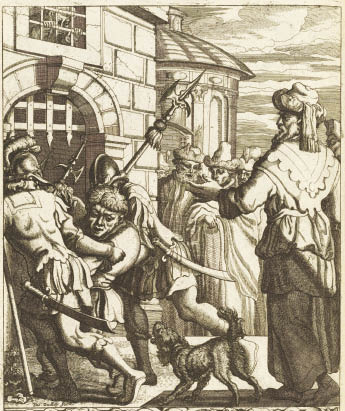
Francis Barlow. Æsop's Fables. (London: 1687).
In the second accusation, a magistrate intercepted Aesop on the street and asked him where he was going. Aesop answered, "I don't know."
This annoyed the magistrate who ordered him taken to prison. As he was being taken away Aesop replied, "You see I told the truth. I didn't know I was going to prison." Amused, the magistrate let him go.
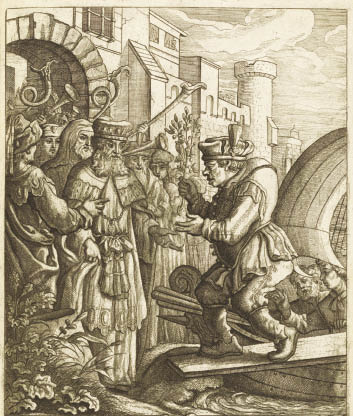
Francis Barlow. Æsop's Fables. (London: 1687).
The third occurred in Babylon after Aesop adopted Helios (or Aenus or Eunus), an ungrateful young man who plotted his ruin. Helios forged letters that implicated Aesop in treason. Aesop was imprisoned and left for dead. Later King Lycurgus, frantic with perplexity, lamented that Aesop was dead when he was badly needed, then rejoiced to learn he was alive.
Aesop promptly solved the King's problem, then took Helios aside to instruct him with maxim after maxim. For instance, "Be cautious and civil. With a wagging tail a dog gets fed, but with a barking mouth, beatings." Humiliated, Helios starved himself to death.
The fourth accusation cost Aesop his life. According to Planudes, Aesop's intelligence won him positions of high responsibility. He solved the problems of three kings, Croesus of Lydia, Lycurgus of Babylon, and Nectanabo of Egypt. Barlow illustrated his reception by Croesus.
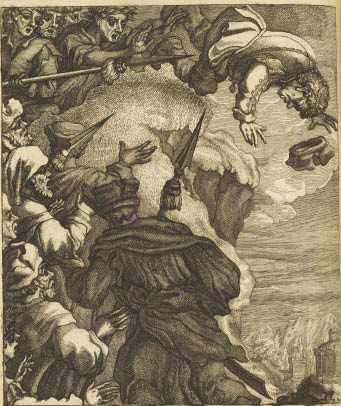
Francis Barlow. Æsop's Fables. (London: 1687).
Aesop traveled from Babylon to Greece. In Delphi, he was scandalized by the greed and arrogance of its people. His sharp wit insulted the magistrates, who plotted to shame and kill him. Planting a gold cup in his baggage, they found it, identified it as stolen from a temple, and convicted Aesop of blasphemy and theft. Aesop tried to talk his way out of it with a series of fables, but to no avail. Sometimes fables fail.
He was thrown from a cliff to his death. His death brought retribution. Zeus punished Delphi with famine and other Greeks punished it with a "severe revenge."
The appeal of the Life and the fables was instant and enduring. When print spread across Europe in the fifteenth century, the first ancient Greek work to be printed was Aesop, and Planudes's Life, for all its flaws, was printed with it.

